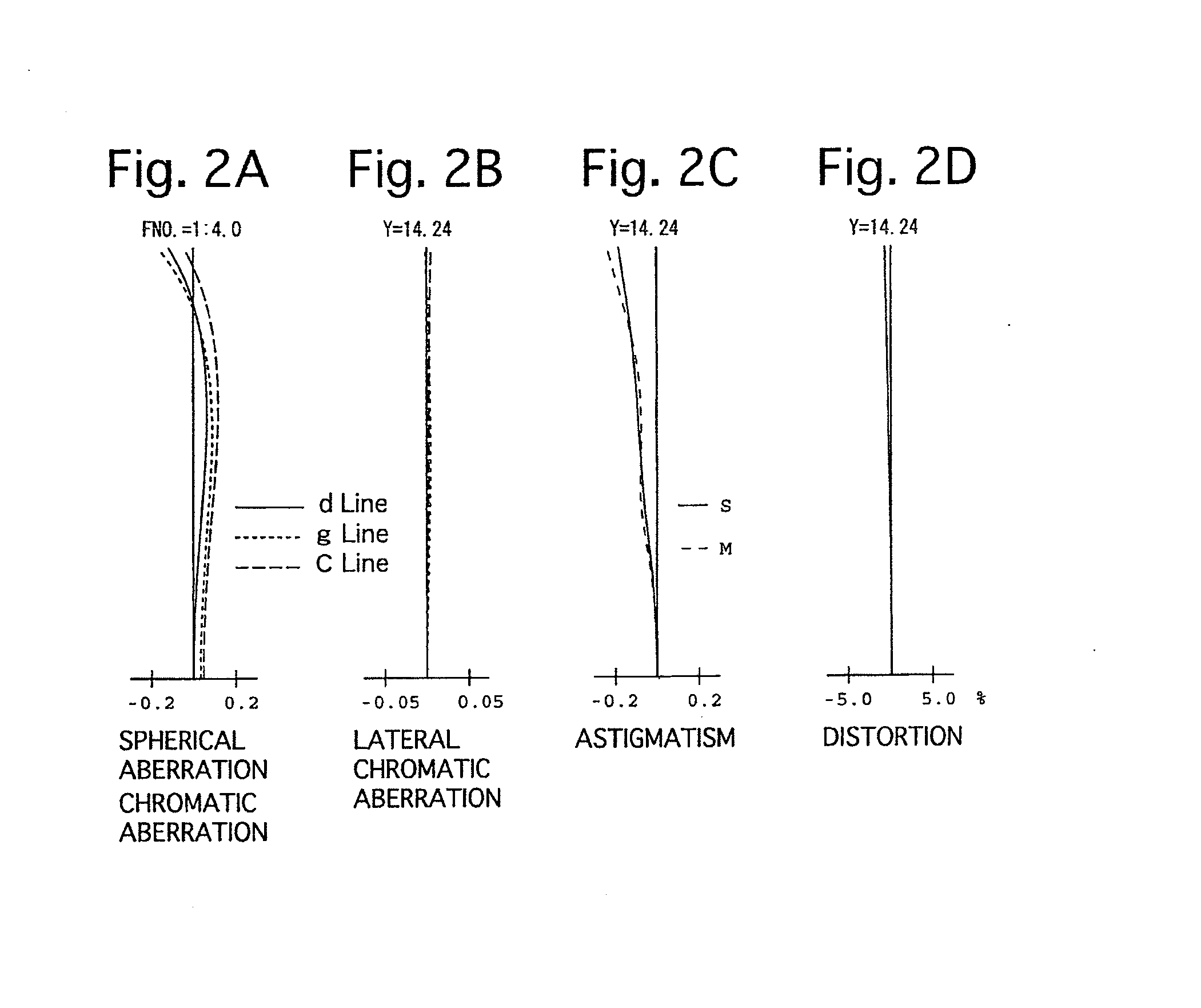Zoom lens system
a zoom lens and lens body technology, applied in the field of zoom lens systems, can solve the problems of deteriorating optical quality, insufficient brightness, easy deterioration of optical quality, etc., and achieves the effects of fast f-number, superior optical quality, and simple and low-cost mechanical structur
- Summary
- Abstract
- Description
- Claims
- Application Information
AI Technical Summary
Benefits of technology
Problems solved by technology
Method used
Image
Examples
numerical embodiment 1
[0099]FIGS. 1 through 6 and Tables 1 through 4 show a first numerical embodiment of the zoom lens system according to the present invention. FIG. 1 shows the lens arrangement at the long focal length extremity when focused on an object at infinity, FIG. 2 shows the various aberrations thereof, FIG. 3 shows the lateral aberrations thereof; FIG. 4 shows the lens arrangement at the short focal length extremity when focused on an object at infinity, FIG. 5 shows the various aberrations thereof, and FIG. 6 shows the lateral aberrations thereof. Table 1 shows the lens surface data, Table 2 shows the aspherical surface data, Table 3 shows various data of the zoom lens system, and Table 4 shows various data of the lens groups.
[0100]The zoom lens system of the first numerical embodiment is configured of a negative first lens group G1 and a positive second lens group G2, in that order from the object side.
[0101]The first lens group G1 is configured of a negative meniscus lens element 11 havin...
numerical embodiment 2
[0105]FIGS. 7 through 12 and Tables 5 through 8 show a second numerical embodiment of the zoom lens system according to the present invention. FIG. 7 shows the lens arrangement at the long focal length extremity when focused on an object at infinity, FIG. 8 shows the various aberrations thereof, FIG. 9 shows the lateral aberrations thereof; FIG. 10 shows the lens arrangement at the short focal length extremity when focused on an object at infinity, FIG. 11 shows the various aberrations thereof, and FIG. 12 shows the lateral aberrations thereof. Table 5 shows the lens surface data, Table 6 shows the aspherical surface data, Table 7 shows various data of the zoom lens system, and Table 8 shows various data of the lens groups.
[0106]The lens arrangement of the second numerical embodiment is the same as that of the first numerical embodiment.
TABLE 5SURFACE DATASurf. No.RdN(d)ν(d) 149.7781.5661.7413153.5 216.6205.824 343.0443.0221.6890052.8 4*19.2688.658 533.5492.9761.7449827.2 675.431d6 ...
numerical embodiment 3
[0107]FIGS. 13 through 18 and Tables 9 through 12 show a third numerical embodiment of the zoom lens system according to the present invention. FIG. 13 shows the lens arrangement at the long focal length extremity when focused on an object at infinity, FIG. 14 shows the various aberrations thereof, FIG. 15 shows the lateral aberrations thereof; FIG. 16 shows the lens arrangement at the short focal length extremity when focused on an object at infinity, FIG. 17 shows the various aberrations thereof, and FIG. 18 shows the lateral aberrations thereof. Table 9 shows the lens surface data, Table 10 shows the aspherical surface data, Table 11 shows various data of the zoom lens system, and Table 12 shows various data of the lens groups.
[0108]The lens arrangement of the third numerical embodiment is the same as that of the first numerical embodiment except for the following features:
[0109](1) The first sub-lens group G2A is configured of a biconvex positive lens element 21′, a positive men...
PUM
 Login to View More
Login to View More Abstract
Description
Claims
Application Information
 Login to View More
Login to View More - R&D
- Intellectual Property
- Life Sciences
- Materials
- Tech Scout
- Unparalleled Data Quality
- Higher Quality Content
- 60% Fewer Hallucinations
Browse by: Latest US Patents, China's latest patents, Technical Efficacy Thesaurus, Application Domain, Technology Topic, Popular Technical Reports.
© 2025 PatSnap. All rights reserved.Legal|Privacy policy|Modern Slavery Act Transparency Statement|Sitemap|About US| Contact US: help@patsnap.com



